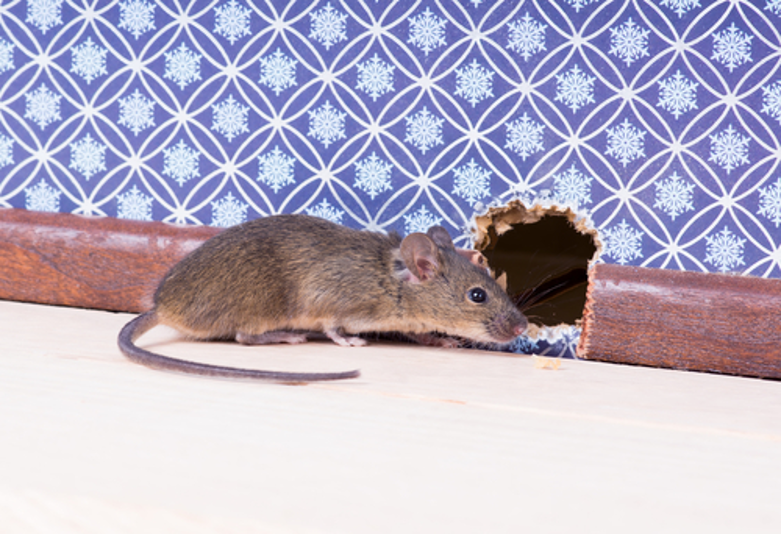What are Carpet Beetles? Signs You Have Them & How to Get Rid of Them
These black beetles are infamous for infesting carpet. They’re not just infesting your carpet, either… They’re eating it, laying eggs in it, and damaging it. These black beetles are called carpet beetles. And if you’ve found one carpet beetle… you’ll probably find more.
If you’ve discovered a carpet beetle infestation in your home, there’s a good chance you’re desperate to get rid of it and then make sure you never have one again. Plunkett’s can help with that. Here’s everything you need to know about carpet beetles in order to keep them out of your home.
What are Carpet Beetles?
Carpet beetles are beetles that lay eggs in fibrous material such as carpeting so their offspring can feed on it. Carpet beetles are oval-shaped and about ⅛” long—however, they vary in color based on their species and maturity.
What Do Carpet Beetles Look Like?
What a carpet beetle looks like depends on the species. The three most common carpet beetle species in the US are:
1. The Black Carpet Beetle
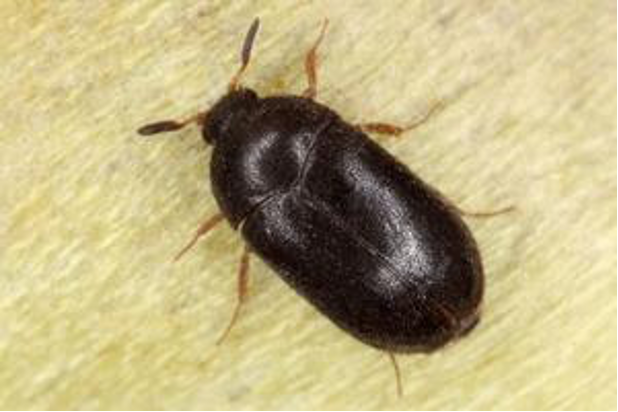
Black carpet beetles feed on both fabric and stored products such as grains. Black carpet beetles are dark brown or black, bullet-shaped beetles with brown legs and antennae. Their larvae often grow to ½” in length, look carrot-shaped, and are covered in golden-brown hair.
2. The Varied Carpet Beetle
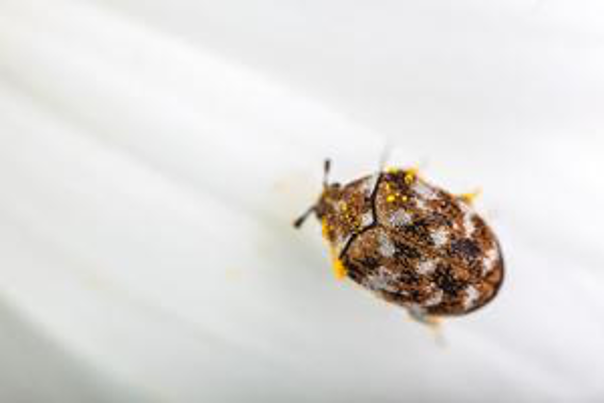
The varied carpet beetle eats dead insects and a wide variety of fabric and other fibrous material. Adult Varied carpet beetles are 2-3 mm long. Their elytra (wing covers) and back are covered with spots of white, brown, and yellow color, giving the beetle a “splotchy” appearance. Varied carpet beetle larvae are 4-5 mm long and are covered in bristly tufts of hair.
3. The Common Carpet Beetle (Buffalo Carpet Beetle)
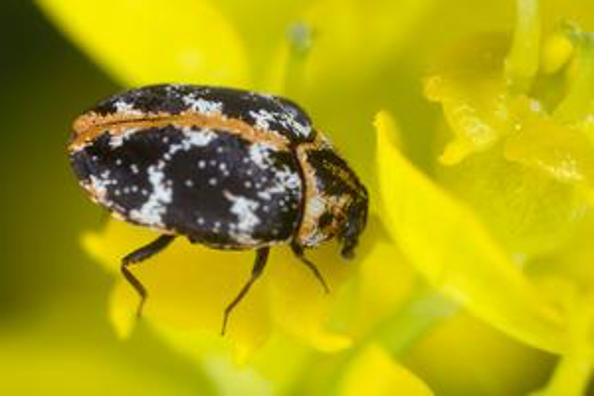
The common carpet beetle eats material made from animal byproducts. Adults are 2.5 to 3.8mm long. Their elytra and thoraxes are covered in black and white patterned scales. They also have distinctive bright red and orange scales running down the midline of the thorax. Larvae are 2.5 to 5 mm long, reddish-brown, and covered in fine bristled hairs.
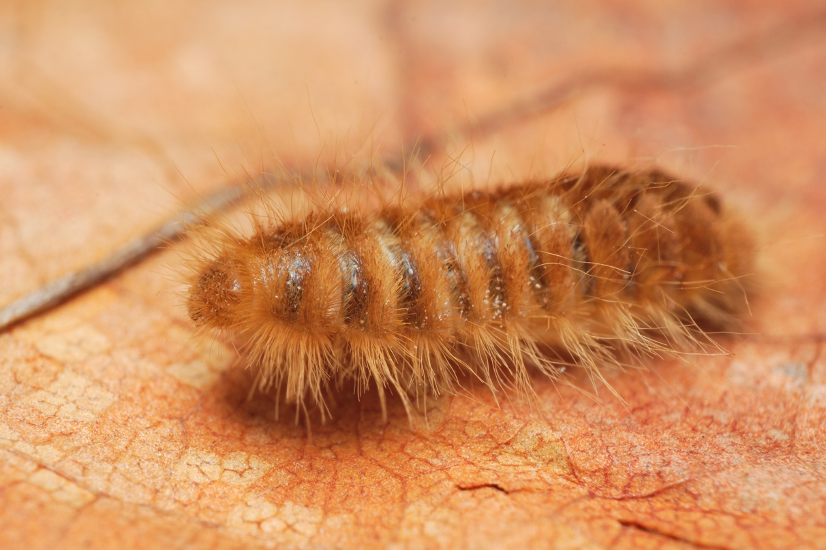
Close up photo of carpet beetle larvae
Do Carpet Beetles Bite?
No, carpet beetles do not bite. In fact, adult carpet beetles don’t even feed on fabrics; it’s the carpet beetle larvae that feed on fabric. Carpet beetles hide in dark, secluded places in your home, and you may confuse them for bed bugs, because they can infest beds eat dead skin cells left in the sheets.
Unlike bed bugs, however, carpet beetles won’t bite you. The bristly hairs on carpet beetle larvae may irritate your skin if you’re allergic to them, however. Coming into contact with carpet beetles when you’re allergic may create a rash or bite-like marks on your skin.
Signs of a Carpet Beetle Infestation: How Can I Tell if I Have Carpet Beetles?
Before you see the beetles for yourself and there are actual bugs found in your carpet, you may notice a few signs of a carpet beetle infestation, including:
- Damage on commonly infested items including bed sheets, linens, clothing, drapes, and (of course) carpet. Carpet beetles will also eat through the fabrics in your home.
- Large, isolated holes in the fabric.
- Carpet Beetle Shedding. As beetle larvae feed, they’ll need to shed their skin to keep growing. Shed carpet beetle skin is translucent, dry, and flakey. Carpet beetles will shed their skin where they’re eating.
- Tiny beetles slowly climbing walls or dead at windowsills.
Where Do Carpet Beetles Come From?
Beetle larvae (not adult beetles) do the damaging and feeding we associate with the pest. Instead of eating fabric, adult beetles seek out flower nectar. They’re often attracted to flowers in your yard. Many adult beetles inadvertently fly into homes while moving from flower to flower looking for nectar.
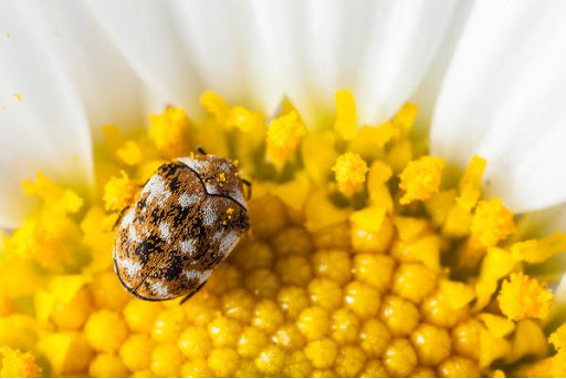
They’ll fly or crawl through gaps in window and door frames, cracks in siding, or through openings near utility lines. Beetles become more active in warm weather, so infestations commonly begin in summer. Carpet beetles prefer to feed and lay eggs in dark, sheltered areas.
Adult beetles actively seek out food sources in these preferred places before they lay their eggs. Consequently, many beetle infestations start in attics or other dark, out-of-the-way places.
Beetle larvae tend to feed on places where predators won’t notice them, such as undersides or beneath folds. Like bed bugs, carpet beetles tend to be so small that they’re quite difficult to notice. Some infestations begin after homeowners accidentally bring a beetle inside on a fabric garment.
How can I prevent carpet beetle infestations?
Carpet beetles are attracted to easily consumed food sources. Although they can chew through whole fabric, they’re more likely to seek out damaged or torn fabrics. They’re particularly prone to eating lint, dust, hairballs, damaged furniture, and dead insects.
Here’s how to keep carpet beetles out of your home:
1. Clean Up Debris
Regularly vacuum, sweep, and dust, especially in areas where carpet beetle infestations are more likely (like your attic).
2. Throw Out Old Materials
Go through your storage and throw out old and worn belongings. Carpet beetle infestations last longest when larvae have a consistent source of food. Usually, this consistent source will be an old, damaged, or dirty rug or other pieces of fabric. Stored clothing, old rugs and carpeting, or dirty sheets are all particularly likely infestation sites.
3. Wash Fabrics Regularly
Thoroughly clean and wash all the fabrics you keep in your home on a regular basis. When you’re not using the fabric, store it somewhere airtight to make it harder for beetles to access.
Keep Beetles Out of Your Carpet with Plunkett’s Pest Control!
Hopefully, we’ve helped you understand how to get rid of carpet beetles. However, if you ever need extra help with cleaning up, preventing, or removing a carpet beetle infestation, give Plunkett’s a call any time.

